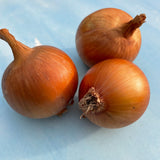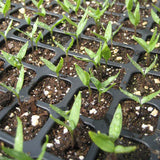
The Versatile Radish
 This radish image is from a late 1800s Rice Seeds trading card.
This radish image is from a late 1800s Rice Seeds trading card.One of the first crops to come out of the spring garden is the humble radish: small, crunchy, brightly colored, and sharply flavored. Many people accept the radish harvest somewhat begrudgingly. The roots have none of the allure of the more sweet crops to come later in the season, such as carrots and tomatoes, but they are ready in May, determined and hairy-leaved harbingers of the harvest to come. They are few gardeners' favorite crops, but they give hope and fresh crunchy texture when little else from the garden does.
Surely the standard American treatment of radishes--eaten fresh only, sliced thinly in salads--is to blame for this lack of excitement, as radishes served this way stay very sharp in flavor, demanding a dressing or sweet counterpoint. While a radish adornment on a salad can indeed be tasty, radishes that are roasted or steamed are a whole other experience: their flavor is mellowed and sweeter, and their texture is remarkably juicy. Dressed with your favorite seasonings, they sing of spring and good garden eating.
The radish is also highly versatile in the garden. Most varieties mature in about six weeks, which make them one of the fastest of all garden crops. Sown in early April, they are ready by mid-May. Because of this quick maturity, they can be sown alongside slower crops such as carrots or tomatoes or peas. The radish harvest will cede space and soil nutrition to the slowpokes right when they are ready for it. They do not hold well in the soil in spring: they swell from the good-eating stage to the pithy stage within a week. It's best to harvest all the radishes when they are just ready to eat and then store them in the fridge; they will keep for several weeks as long as you remove the greens first. (The greens are edible and are really nice in soups or stir-fried with the steamed roots.) For steady fresh radishes, sow in succession until about June 1st, then start again in August for a fall crop, which will hold much more nicely in the cooling soils of autumn.
 Radical Radishes
Radical Radishes





